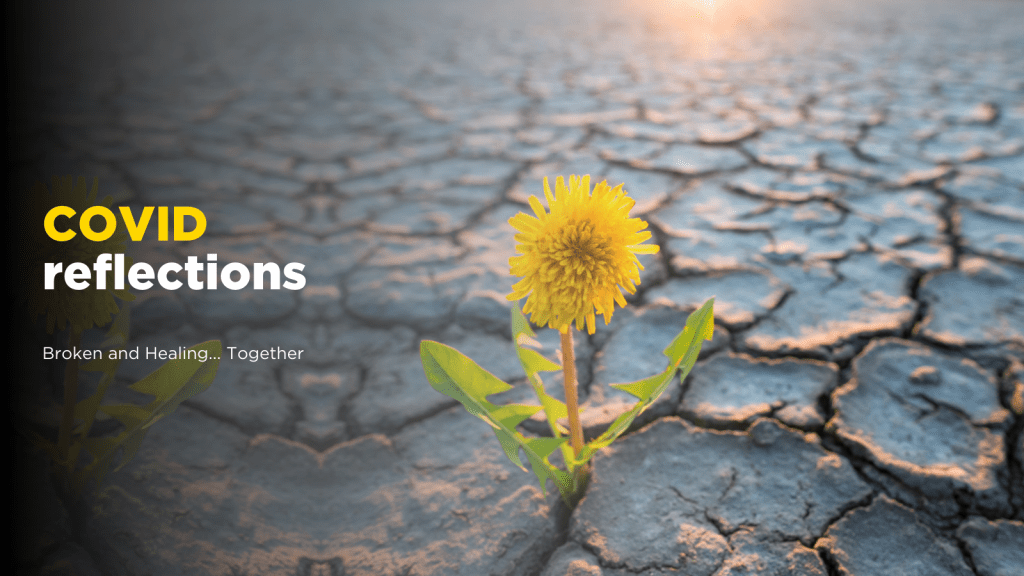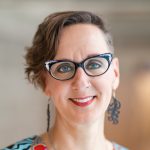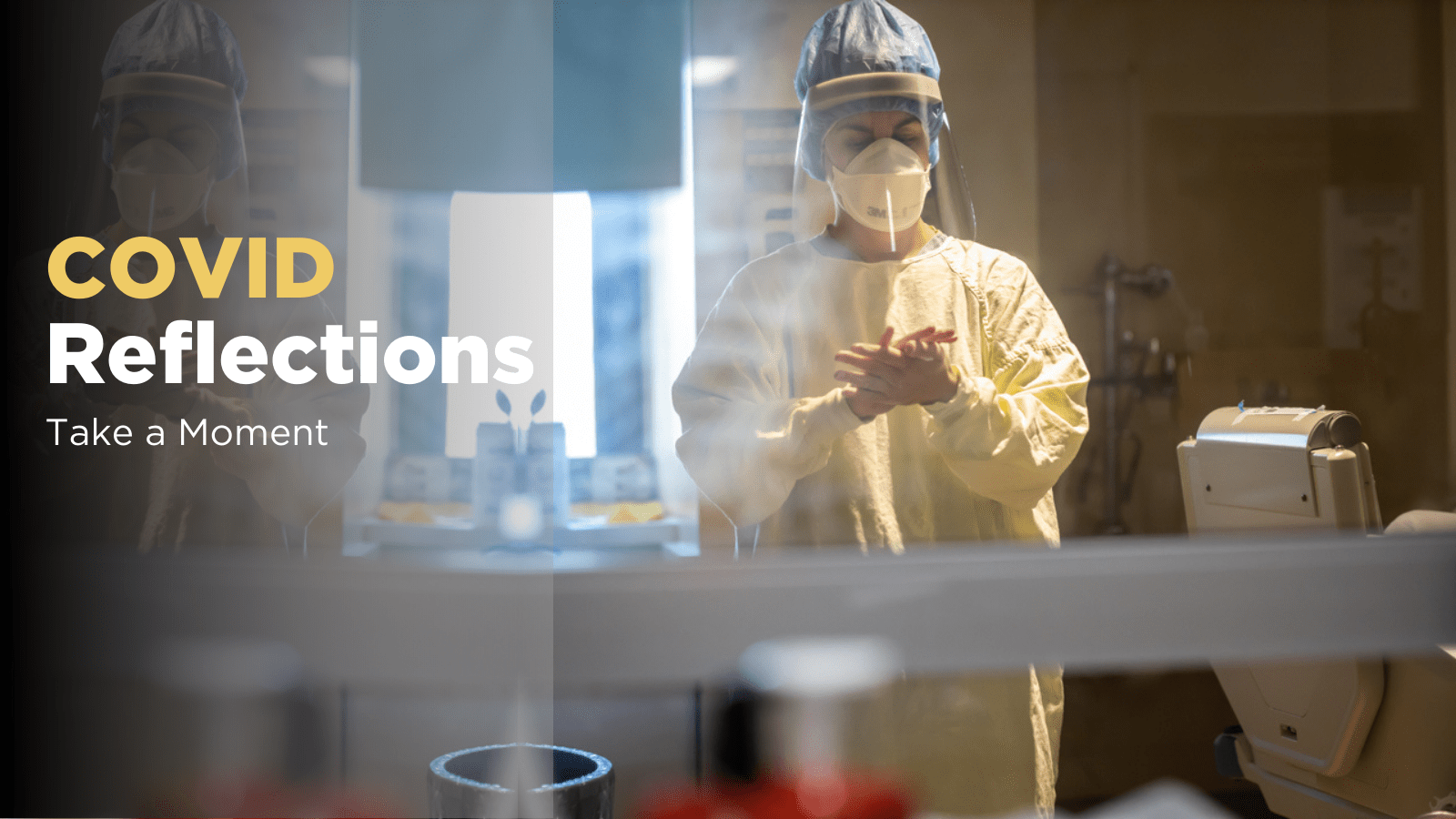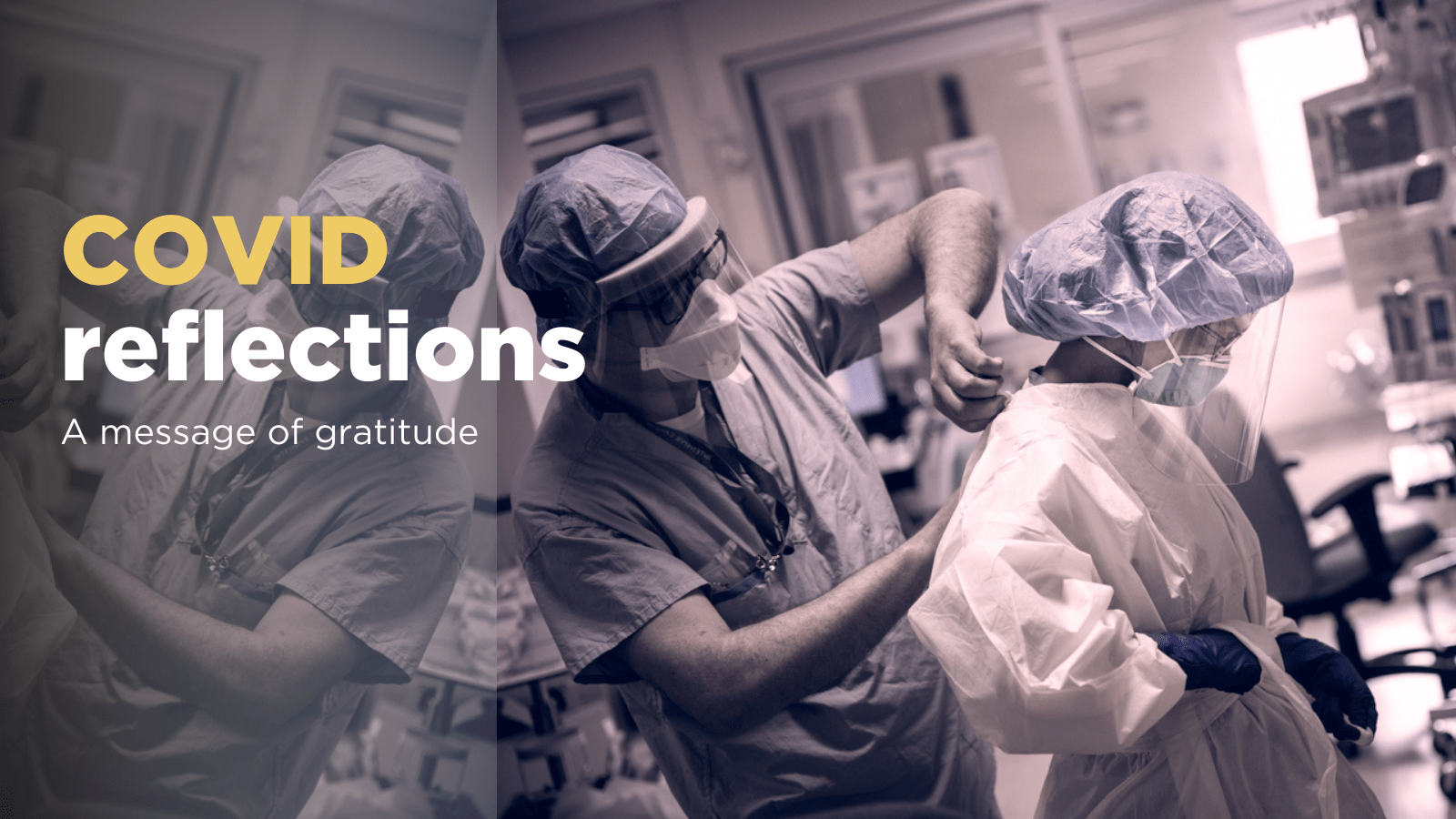
COVID reflections: Broken and healing…together
 By Andrea Frolic, PhD
By Andrea Frolic, PhD
Director, Program for Ethics and Care Ecologies (PEaCE)
My foot is broken. My injury has no great story. Last week, early in the morning, I stumbled into the door frame of my bathroom as I rushed to get ready for work.
First, I swore. Loudly. Then I hopped around on the other foot. Eventually the pain subsided enough to get through my morning routine, while cursing my foot for its insistent throbbing that made me late for my 7 a.m. pandemic response meeting.
Pushing through
For the past year, pandemic response has been my life from 7 a.m. to 7 p.m. most weekdays, and often weekends too. Assuming it was just a stubbed toe, I pushed through meetings about allocating vaccine, potential surging hospitalizations, and the spiritual needs of patients and staff. Once or twice I noticed that my foot had developed its own heartbeat, but I was busy responding to another round of COVID challenges, so I ignored it.
Only when I tried to slip on my winter boots to go home did I realize something was very wrong. My boot was too tight. Taking off my sock, I gasped in shock. My two small toes were swollen and blue-turning-black. Finally, the truth registered; this was no mere abrasion, but a wound in the bone. And in that moment, some place deep within me whispered to that toe of mine, “I get it, I am bruised and broken too.”
Since that day I have had to move differently through the world or risk hurting myself more, perhaps irreparably. My cumbersome airboot gives me the support I need to bear weight and navigate my life now. In my boot I am a person who is both in pain and resilient. It broadcasts to the world that I am the walking wounded and it invites gestures of care: my friend carries my briefcase up to my office, my daughter changes her quick stride to match my hobble.
Masking our collective brokenness
Suddenly forced to stop rushing, I have begun to consider: what does it mean to be both broken and healing as a person, but also as a member of a healthcare system crippled by this pandemic?
My new brokenness has revealed an accumulation of breaks acquired over time, like the thin lines of bone scarring revealed by an X-ray. Looking into the eyes of my colleagues on a hospital ward or the faces that appear in my Zoom squares, I can see how our outward resolve is masking our collective brokenness.
The long, slow grinding of this pandemic against the soft flesh and brittle bones of our healthcare system has led to so many losses:
- We lost our delusions of infallibility when our careful plans were shredded by the virus, and we couldn’t protect the people we swore to keep safe.
- We lost our ability to experience joy or hope or excitement, so numbed are we by constant exhaustion, worry and unattainable expectations.
- We lost of our sense of belonging, so isolated are we from our friends who can’t understand our experience of working in a state of constant vigilance for 12 consecutive months.
Carrying our losses
COVID has created losses that none of us could have fathomed a year ago when the pandemic was declared.
Try this experiment. When you have a few quiet moments, take out a pen and paper, and set a timer for 15 minutes. Now, as quickly as they come to mind, list all the things you have lost during COVID. Little things like your neighborhood Halloween party, or your nephew’s hockey tournaments. Big things like your best friend’s 50th birthday party, or the uncle who passed away and was not publicly mourned.
While convalescing with my broken foot, I did this exercise and in 15 minutes I came up with 50 losses. After 30 minutes my list totaled 115 losses. Some large and traumatic, some trivial — but each carrying a measure of sorrow.
I am not special. I know that every person I encounter is carrying more than 100 losses from this past year.
In healthcare, these losses are compounded by the professional shame we feel in admitting our sorrow and brokenness.
We can’t heal what we can’t feel
I was trained in techniques of emotional distancing and feigned invulnerability. I am not supposed to grieve when a patient dies, or ask for a breather when a family’s rage at the system lands on me like a punch in the gut. I am not supposed to miss my cherished colleagues who leave healthcare, hollowed by the suffering they have witnessed.
As a healthcare leader I am supposed to be a cheerleader, a silver-lining finder, an opportunity-seeker—a hero, not a human. Yes, COVID has had its upsides. And all of us want desperately to get to the post-traumatic growth stage of this pandemic. This explains our current obsession with the minutiae of vaccine deployment. But we can’t heal what we can’t feel.
Creating the conditions for healing
The conditions for healing these losses resemble my experience with my broken foot. But I can’t create these conditions alone; the collective trauma of COVID requires a collective invitation to mourn.
First, we have to acknowledge what is broken and make space to grieve our losses—the losses of lives for sure, but also the loss of a way of life. We need to stop expecting each other to bury our pain in order to grind through our tasks. Delayed treatment of a broken foot can lead to lifelong pain and disability. Delayed support for psychological trauma and unresolved grief can lead to relationship breakdown, maladaptive coping and worse.
Second, we need to get some diagnostics. Each of us can start looking at the losses we have experienced this year. We can give each other permission to grieve, without apologizing for “being a downer” or feeling guilt because “other people are worse off than me” (that doesn’t cancel our own sorrows).
Third, we can create spaces for talking about loss, shedding tears, memorializing the dead, mourning the lives we haven’t been allowed to live, and the lives that will never be the same again. My boot is a supportive structure that allows me to do my job even though I am still broken. Collective grieving can be supported through moments of silence; rituals of remembrance; or simply deeply listening to each other’s sorrow.
Determination to reflect, remember and heal
We can’t wait until the pandemic ends. We can be broken and healing at the same time. In fact, all of us already are. Giving permission to acknowledge our collective suffering won’t cripple us. It will strengthen us.
Thursday, March 11, 2021 marks one year since COVID-19 was declared a pandemic by the World Health Organization. So far, more than 22,000 Canadians have died of COVID; that equates to half the number who died in World War II.
I intend to make this anniversary a day of reflection and remembrance for myself and my healthcare colleagues. A day for us to mourn together the dead. A day to grieve the profound ruptures and traumas our frontline and essential workers have experienced. A day to feel the accumulation of tiny losses that have drained life of simple but durable pleasures.
Please join me to pause, to grieve, and to be together in our brokenness, and together in our determination to heal.


